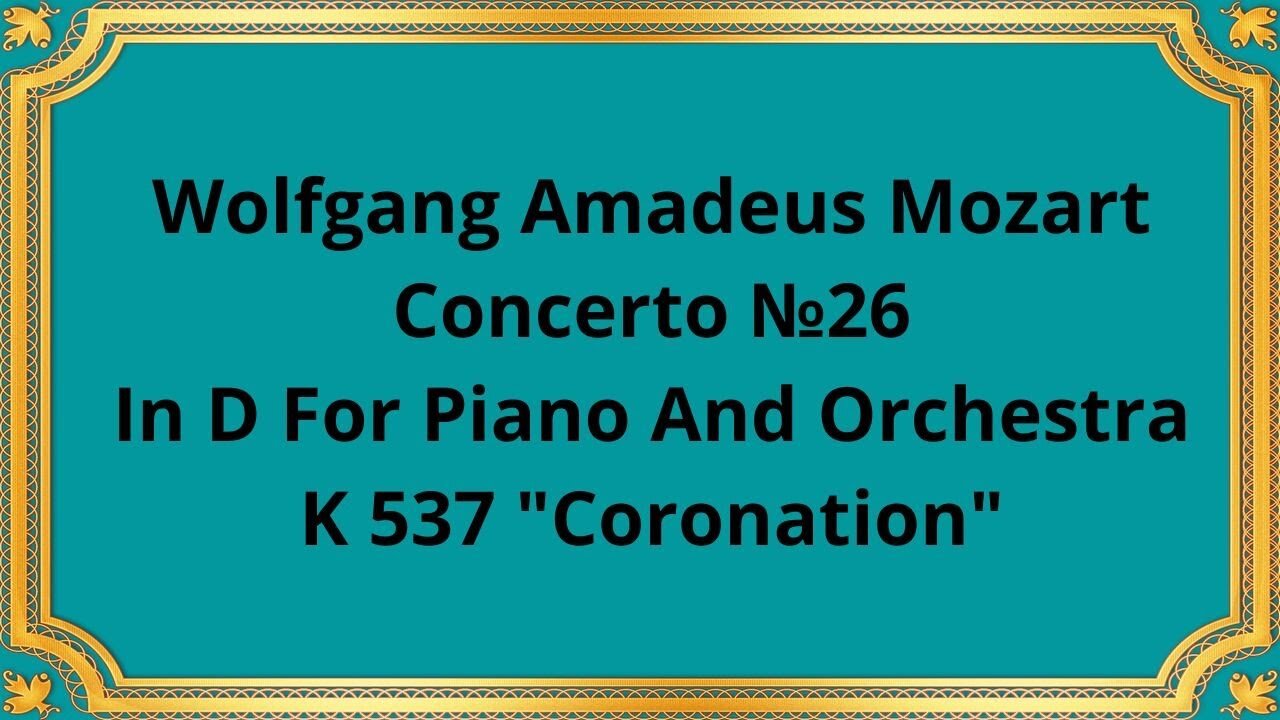Premium Only Content

Wolfgang Amadeus Mozart Concerto №26 In D For Piano And Orchestra, K 537 "Coronation"
#Mozart #classicalmusic #pianoconcerto #CoronationConcerto #musicalcomposition #orchestra #Dmajor #K537 #WolfgangAmadeusMozart
Publication date 1965
Camerata Academica of the Salzburg Mozarteum Soloist and conductor: Géza Anda
Wolfgang Amadeus Mozart, a prolific composer of the Classical era, created numerous masterpieces that continue to captivate audiences to this day. Among his remarkable works, Concerto No. 26 in D for Piano and Orchestra, K 537, commonly known as the "Coronation Concerto," stands as a testament to Mozart's genius and musical prowess.
Composed in 1788, during Mozart's most productive period, the "Coronation Concerto" holds a significant place in his repertoire. It was written in honor of the coronation of Emperor Leopold II as King of Bohemia. This composition showcases Mozart's ability to create grand and majestic works suitable for important occasions.
The concerto follows the traditional three-movement structure commonly found in classical concertos. It begins with an Allegro movement, followed by a Larghetto, and concludes with a lively Allegretto. Mozart's choice of D major as the key for this concerto adds to its vibrant and celebratory nature.
The concerto is scored for solo piano and a full orchestra, including strings, woodwinds, brass, and timpani. Mozart's masterful orchestration allows the piano and orchestra to engage in a delightful musical dialogue.
The "Coronation Concerto" showcases Mozart's virtuosity as a pianist and his ability to write demanding yet expressive piano passages. The solo piano part requires exceptional dexterity, precision, and musicality from the performer.
Mozart's gift for crafting beautiful melodies is evident throughout this concerto. From the soaring piano lines to the rich orchestral melodies, the "Coronation Concerto" is filled with moments of emotional depth and lyrical beauty.
Each movement of the concerto presents distinct moods and characters. The opening Allegro is grand and energetic, the Larghetto is serene and introspective, while the concluding Allegretto is lively and joyful. This variety of emotions adds depth and interest to the overall composition.
The "Coronation Concerto" has continued to be revered by musicians and audiences alike for its technical brilliance and musical depth. Its popularity has ensured its place in the standard repertoire of piano concertos, performed by virtuoso pianists around the world. The composition's enduring appeal speaks to Mozart's ability to create timeless music that transcends the boundaries of time and place.
Conclusion:
Wolfgang Amadeus Mozart's Concerto No. 26 in D for Piano and Orchestra, K 537 "Coronation" remains a shining example of his musical genius. Its majestic nature, expressive melodies, and technical complexity make it a cherished piece in the classical music canon. By understanding the historical context, structure, and notable characteristics of this composition, one can truly appreciate Mozart's mastery and the enduring legacy of his music.
You have the opportunity to support the channel:
https://destream.net/live/RadSiarAl/donate
https://www.buymeacoffee.com/6355radsiaral
-
 DVR
DVR
The Trish Regan Show
5 hours agoTrump‘s FCC Targets Disney CEO Bob Iger Over ABC News Alleged Misconduct
25.4K20 -
 1:48:19
1:48:19
The Quartering
5 hours agoElon Calls White People Dumb, Vivek Calls American's Lazy & Why Modern Christmas Movies Suck!
94.9K69 -
 2:08:42
2:08:42
The Dilley Show
6 hours ago $28.05 earnedH1B Visa Debate, Culture and More! w/Author Brenden Dilley 12/26/2024
80.2K22 -
 4:55:59
4:55:59
LumpyPotatoX2
9 hours agoThirsty Thursday on BOX Day - #RumbleGaming
84.3K5 -
 1:04:52
1:04:52
Geeks + Gamers
7 hours agoDisney RATIO'D on Christmas Day | Mufasa Embarrassed By Sonic 3
62.8K5 -
 8:27:46
8:27:46
Sm0k3m
12 hours agoPlaying games on Rumble
38.2K2 -
 10:37
10:37
Russell Brand
2 days agoHow is this even allowed?
186K857 -
 1:37:26
1:37:26
Real Coffee With Scott Adams
8 hours agoEpisode 2701 CWSA 12/26/24
102K92 -
 2:58:58
2:58:58
Wendy Bell Radio
13 hours ago9 Steps Ahead
129K141 -
 2:03:46
2:03:46
LFA TV
21 hours agoTIME FOR A NEW SPEAKER! | LIVE FROM AMERICA 12.26.24 11am EST
77.7K54